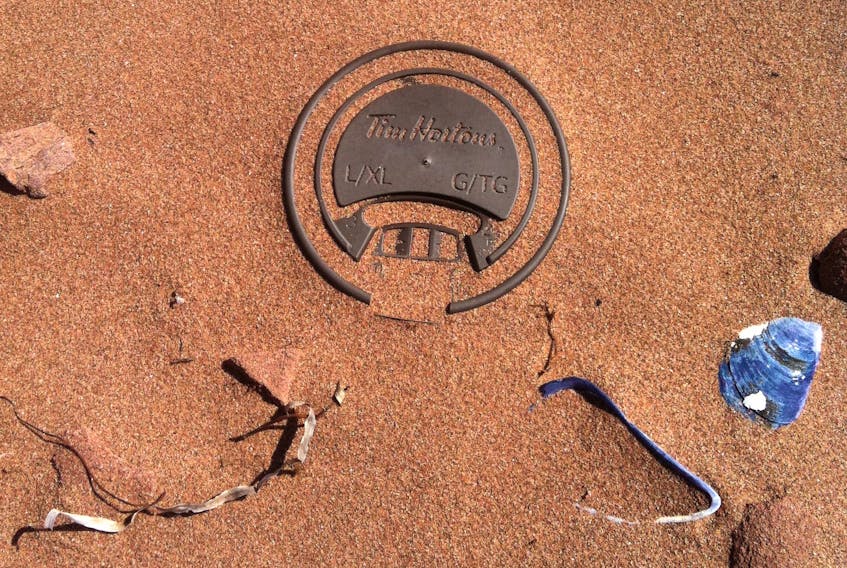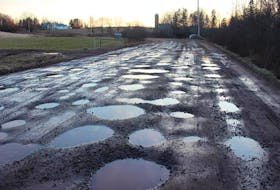As you sow, so shall you eat.
OK, that’s not really the saying, but you’ll see what I mean in a moment.
It always amazes me that, no matter how far away from the beaten track you get, you can always find plastic trash.

Deep in Nova Scotia’s Highway 8, on the long empty run from west coast to east, I stopped near Harmony Mills for just a moment, only to find Captain Morgan starting at me from a floating plastic flask bottle in the ditch. A handful of miles later, passed regularly by speeding logging trucks, a stop next to a slowly regrowing clear-cut included an empty plastic vodka bottle and two plastic water bottles.
Atop a knuckle of high-ground rock between Newfoundland’s Adam’s Cove and Bradley’s Cove, there was the skeleton of a dead sheep with grass growing up through its ribs, a stone fire pit with long-soaked half-burned logs and a collection of plastic bottles, nestled together as if seeking warmth.
P.E.I.’s sand beaches are gorgeous, but you can play a game of collecting plastic twist-off bottle caps and never get skunked — in fact, never be short of a full handful, no matter how far away you walk from the main beaches.
Scientists have found plastics, and their broken-down microplastic bits, in places so far flung that humans have never actually been there. A study released in mid-November found that, at the bottom of the deepest ocean trenches in the world — the Mariana, Japan, Izu-Bonin, Peru-Chile, New Hebrides and Kermadec trenches in the Pacific — as much as 100 per cent of deep-sea crustaceans were found to have plastic fibres in their digestive systems.
In fact, when it comes to the ocean, there are now suggestions that there is plastic simply everywhere: there are the well-known and well-reported giant spinning gyres of floating trash in the Pacific, off Chile, and, most recently, in the Caribbean. The images of near-endless plastic waste floating in vast mats is startling enough.
P.E.I.’s sand beaches are gorgeous, but you can play a game of collecting plastic twist-off bottle caps and never get skunked…
But research done off Norway is even more startling, not because you can see the plastic, but because you can’t.
Scientists with the Norwegian Institute of Water Research sampled blue mussels — the ones that are so popular for human consumption — for microplastics contamination at 13 sites along the Norwegian coast, including a site at Finnmark, the furthest northern edge of the country. At every single site, mussels — which are filter-feeders — were found to be carrying tiny plastic bits in their internal organs. Out of the entire sample, 76.6 per cent of the mussels were contaminated with plastics.
And not just basic plastics: “In addition to semi-synthetic cellulosic polymers, other polymers isolated from blue mussels included polyesters, polypropylene and polyethylene, Ethylene-vinyl acetate foam and epoxy resin. Potential sources of these particles could range from textiles, general use plastics, paints, and finally, oil and tar,” the report says.
And the problem’s only going to grow: “Microplastic pollution is projected to increase in the foreseeable future with the continued environmental breakdown and fragmentation of present stocks and future production of plastic items.”
Already, 97 per cent of beached litter in the Arctic is plastic. For those marine organisms, eating plastic has clear problems: the mussel study points out that, “Laboratory studies have identified some potential effects of microplastic exposure including: increased immune response, decreased food consumption, weight loss, energy depletion, decreased growth rate, decreased fecundity and impacts on subsequent generations.”
So far, there aren’t comparable concerns about humans eating plastic-contaminated sea life. But you know, we’re animals, too — and you are what you eat.
If anything, we deserve to suffer the effects of our mess.
Nature’s only giving back what we regularly give it.
Russell Wangersky’s column appears in 39 SaltWire newspapers and websites in Atlantic Canada. He can be reached at [email protected] — Twitter: @wangersky.









